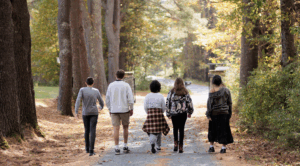As we transition back to a post-COVID world, where you are expected to get “back to normal”, are you finding that returning to a daily routine is easier said than done? Is it hard to return to sports, work, social events and school? Where does the difficulty stem from? Is it: fear, sadness, stagnation, or anxiety? Often, this difficulty to return to normal is a sign that there are big emotional challenges ahead. School refusal can be the “canary in the coal mine”; a sign that you are facing some mental health challenges that are becoming insurmountable.
How School Refusal Manifests
Anxiety and depression coupled with a long period of isolation in the home can lead to school avoidance and refusal. Whether the anxiety is based on academics, safety, or social interactions, school is often a hot bed of uncomfortable situations. Around every corner a young person faces the real threat of discomfort, stress, and challenges. It is far easier to stay at home where life is safe and secure, than to learn to sit with discomfort and push through anxious feelings. This can lead to school phobia or a general pattern of school avoidant behavior.
Feelings of stress or anxiety is a normal part of life. It is a natural reaction to a dangerous situation, whether it be real or just perceived. When feelings of anxiety increases in severity or frequency, this normal discomfort could become an anxiety disorder. An anxiety disorder is characterized by intense, excessive and persistent worry and fear about everyday situations. People with excessive anxiety may anticipate disaster and be overly concerned about school, health, family, friends, or other issues. And while anxiety can occur at any age, it can be especially detrimental to the development of teens and adolescents.
Like other mental health diagnoses, anxiety has symptoms that can affect people of all ages and walks of life. Anxiety typically presents itself with both mental and physical signs.
Common Anxiety Signs and Symptoms Include:
- Nervousness, restlessness or tenseness
- A sense of impending danger, panic or doom
- Increased heart rate and rapid breathing
- Moodiness
- Exhaustion or unexplainable tiredness
- Trouble concentrating during daily tasks
- Difficulties with sleep
- Somatic symptoms such as headaches, muscle aches or stomach distress
- The urge to avoid things that trigger anxiety
When symptoms of anxiety in a young person becomes overwhelming, or begins to affect quality of life, they might be diagnosed with an anxiety disorder. The most common anxiety diagnosis is Generalized Anxiety Disorder (GAD) which is marked by persistent anxiety that is out of proportion with actual circumstances. Other anxiety diagnoses include: Agoraphobia, Panic Attacks, Selective Mutism, Separation Anxiety, Social Anxiety, Obsessive Compulsive Disorder, and Specific Phobias.
The Larger Concerns That School Avoidance Signifies
School avoidance and refusal is often the “emergent situation’ that highlights that normal stress has transformed to a true anxiety disorder. Refusing to attend school is a symptom of the larger problem; it’s important to treat the anxiety in order to return to normal daily activities. The goal is to determine the roots of the anxiety and then help develop new skills and strategies to overcome these feelings.
Treating School Anxiety Disorders
Treatment programs, such as Mountain Valley, help young people learn more about their school anxiety and develop tools to overcome it. Each resident at Mountain Valley receives an individualized treatment plan that includes: therapy, academics, and fun. Every activity at Mountain Valley focuses on the tenets of Cognitive Behavioral Therapy (CBT) and Exposure and Response Prevention (ERP) . CBT and ERP helps young people face the foundation of their anxious feelings and learn how to overcome those feelings. This helps them shatter the cycle of anxiety with a deliberate, careful, and kind approach.
Through approaching school refusal and anxiety by treating the underlying problem, we are able to develop new skills to tackle any discomfort a young person might face. By utilizing evidence based practice to overcome barriers to daily living, young people are able to learn how to “sit with it” and become more comfortable with the inherent challenges that come with being a young person.


